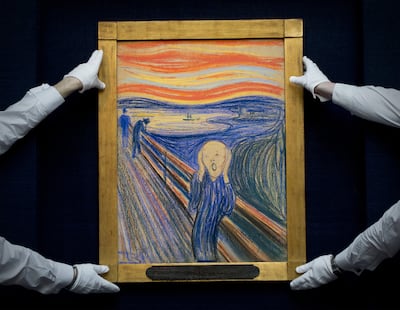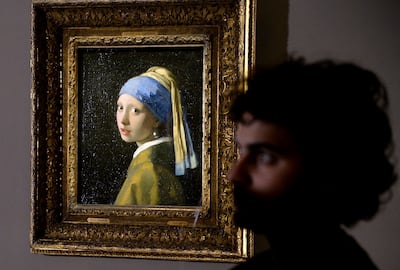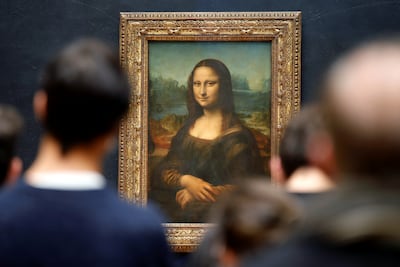Some works of art are so recognisable they’re as familiar to us as our own faces in the mirror.
The likes of Leonardo Da Vinci's Mona Lisa, Edvard Munch's The Scream and Vincent Van Gogh's The Starry Night, are all so firmly ingrained in popular culture that it’s easy to forget these works of art can still have some secrets to spill.
From the debate over whether there is actually an earring in The Girl With a Pearl Earring’s ear, to the view from an asylum window that’s worth millions, here are some fascinating insights into 10 of the world’s most famous artworks …
'The Scream', Edvard Munch

Norwegian artist Munch created his famous piece in 1893, a work which has come to symbolise the anxiety, trauma and isolation of the human condition. What is less known is that the figure in the foreground of the painting isn’t the one doing the screaming. Rather, they are reacting to the scream.
“One evening I was walking along a path, the city was on one side and the fjord below. I felt tired and ill,” Munch wrote in his journal. “I stopped and looked out over the fjord — the sun was setting, and the clouds turning blood red. I sensed a scream passing through nature; it seemed to me that I heard the scream. I painted this picture, painted the clouds as actual blood. The colour shrieked. This became The Scream.”
Additionally, the red sky depicted in The Scream was caused by the aftermath of the Krakatoa volcano eruption in 1883.
'Girl With a Pearl Earring', Johannes Vermeer

Vermeer’s 1665 artwork, which has come to symbolise the Dutch Golden Age, has inspired a book and a film starring Scarlett Johansson about its origins.
However, the art world has long debated whether the girl in the painting is actually wearing an earring, or whether it is simply reflected light, as close inspection shows the “earring” is not attached to her ear.
Vermeer did not call his work Girl With a Pearl Earring, rather that became its official title in 1995, when the Royal Mauritshuis Gallery chose it for the Vermeer exhibition in Washington.
Owing to the girl’s non-European headdress, some art historians believe the work was one of two titled Two Tronies in Turkish Style (two portraits-fantasies), from an inventory of the artist’s work done in 1676.
'American Gothic', Grant Wood
As with Munch’s The Scream, Grant’s work has suffered from misinterpretation over the years, likely owing to the dour looks on his subjects’ faces.
Despite the expressions of the pair, who are actually a father and daughter, not man and wife, Grant had intended the piece, created in 1930, to be a positive representation of rural American values in the face of the Great Depression.
Wood used his sister and his dentist as models for the portrait.
'The Starry Night', Vincent Van Gogh
Painted in 1889, the scene in The Starry Night is the view from the Saint-Paul de Mausole asylum in which the Dutch painter had voluntarily admitted himself to following his breakdown in December 1888, when he mutilated his left ear.
The view is from the east-facing window of his room in the French town of Saint-Remy-de-Provence, although the village is from the artist’s imagination.
The brightest star in the centre is Venus (The Morning Star) which was visible at the time.
'Mona Lisa', Leonardo Da Vinci

Because her smile is so legendary, the background to Da Vinci’s masterpiece is often overlooked, but has inspired as many arguments and debates as her enigmatic lips.
Clearly asymmetrical, the left side of the background is significantly lower than the right, and the landscape itself has been debated by art historians for centuries, as to whether it was real or from the artist’s imagination.
In 1995, University of Florence palaeontologist Carlo Starnazzi published an article stating that the lake on the left is Lake Chiana, and that the winding road is actually a canal linking the lake to the Arno River. On the right, he says, is the Burgiano Bridge that spans the Arno river in Tuscany.
'Sleeping Lady with Black Vase', Robert Bereny
The art world has the 1999 film Stuart Little to thank for the reappearance of a work of art which had been missing since 1928.
While watching the film with his daughter, art historian Gergely Barki, recognised the painting hanging over the Littles' mantelpiece, and realised it was the lost work of avant-garde artist Robert Bereny.
The work had been sold in 1928 and was considered lost after the Second World War. After two years, Barki tracked down the film's set designer, who had bought the painting at an antique shop in California.
It was eventually sold at auction in 2014 to a private collector for $285,700.
'Arnolfini Portrait', Jan van Eyck

It’s a graffiti tag recognised the world over. One seen on walls in every city featuring the graffiti artist’s name, followed by “was here” and the date.
But while a spray-painted scrawl on a city wall might not hold much cachet in the artworld (unless it's by Banksy), the appearance of such a tag in a work of art has only enhanced its value.
Van Eyck’s Arnolfini Portrait, painted in 1434, of the Italian merchant Giovanni di Nicolao Arnolfini and his wife, features a very notable tag on the wall behind the couple. The Latin script reads: “Johannes de eyck fuit hic 1434" which translates to “Jan van Eyck was here in 1434.”
'The Last Supper', Leonardo Da Vinci
It’s one of the most famous paintings in the world. And while visitors to the Louvre often express amazement at how small the Mona Lisa is, visitors to Santa Maria delle Grazie in Milan are usually taken aback at the scale of Da Vinci’s The Last Supper.
Measuring 4.6 metres by 8.8 metres, the work, which was painted between 1495 and 1498, depicts the moment Jesus told his Disciples that one of them would betray him the following day.
Of the many symbolic references in the painting, by Judas’s arm is a container of spilt salt, which was considered a bad omen.
'David', Michelangelo
Standing 5.2 metres tall, Michelangelo’s David is one of the most famous sculptures in the world.
Now housed at the Galleria dell’Accademia in Florence, when it was first unveiled on September 8, 1504, it was situated outside the Palazzo Vecchio, which was the seat of civic government in Florence.
Although admired for its representation of youth and beauty, Michelangelo also imbued David with a political statement.
The statue’s gaze is actually a cautionary glare from the city-state of Florence, directed at Rome, also then a city-state and not yet the Italian capital, as a warning against challenging the city.
'The Weeping Woman', Pablo Picasso
Back in 1986, one of Picasso’s Weeping Woman (there are four version which the artist painted in 1937), was stolen and went missing for three weeks before it was returned — but to this day, no one knows who took it.
The piece was stolen from the National Gallery of Victoria in Melbourne, Australia in August 1986.
The thieves, who called themselves Australian Cultural Terrorists (ACT), quickly issued a list of demands to guarantee its safe return.
These included a 10 per cent increase in arts funding and the creation of a A$25,000 annual art prize which was to be named The Picasso Ransom. The group said the painting would be destroyed in seven days if their demands were not met.
The government refused to negotiate and three weeks after the painting disappeared, police received information that it was in locker 227 of the Spencer Street railway station.
The Weeping Woman was recovered but the members of ACT have never been identified or found.









